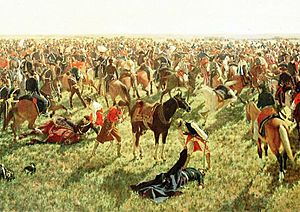Battle of Sarandí facts for kids
Quick facts for kids Battle of Sarandí |
|||||||
|---|---|---|---|---|---|---|---|
| Part of the Cisplatine War | |||||||
 Battle of Sarandí, oil by Juan Manuel Blanes |
|||||||
|
|||||||
| Belligerents | |||||||
| Commanders and leaders | |||||||
| Strength | |||||||
| 1,411 | 2,200-2,600 1 field gun |
||||||
| Casualties and losses | |||||||
| ~200 killed 515-575 captured |
35 killed 90 wounded |
||||||
The Battle of Sarandí was a very important fight that happened on October 12, 1825. It took place near a stream called Arroyo Sarandí in what is now Uruguay. This battle was between soldiers from the Banda Oriental (which is like Uruguay today) and the Empire of Brazil. The Oriental forces won a big victory. This battle was a key part of the Cisplatine War.
Contents
Why the Battle of Sarandí Happened
The region known as the Banda Oriental was taken over by Portugal and Brazil in 1820. It was called Cisplatina then. In 1822, Brazil became independent from Portugal. At that time, the Banda Oriental became a Brazilian province.
Efforts to Gain Freedom
The people of Banda Oriental wanted to be free from foreign rule. On April 19, 1825, a group called the Thirty-Three Orientals landed in the region. They started fighting the Brazilian forces.
Important battles and sieges happened:
- The Siege of Montevideo began on May 8, 1825. Manuel Oribe led this siege.
- The Colonia del Sacramento was also under siege starting August 18, 1825.
The Battle of Rincón
Before Sarandí, the Battle of Rincón took place on September 24, 1825. The Oriental forces won this battle too. This was a big problem for the Brazilian soldiers stuck in Montevideo. They lost many soldiers and about 6,000 horses.
When news of the Rincón defeat reached Montevideo, Brazilian leaders acted quickly. They sent about 1,000 soldiers under Colonel Bento Manuel Ribeiro. Their goal was to meet up with another Brazilian army. This second army was led by General Bento Gonçalves da Silva.
Lavalleja's Plan
Juan Antonio Lavalleja was a leader of the Oriental troops. He was in Durazno when he heard about the Brazilian plan. He wanted to stop the two Brazilian armies from joining forces. His first attempt to stop them was not successful.
However, Lavalleja worked hard to gather his own army. He managed to get a similar number of soldiers. On October 12, 1825, he faced the Brazilian army. The battle happened near the Sarandí creek in what is now the Florida Department.
The Battle Unfolds
On the morning of October 12, Lavalleja learned the enemy was close. He quickly arranged his troops in a long line, ready for battle. They stood on high ground, looking towards the road to Paso de Polanco del Yí.
Oriental Formations
- Soldiers led by Fructuoso Rivera were on the left side. They were near the Sarandí creek.
- The middle of the line was held by troops under Pablo Zufriategui.
- On the right side were the forces led by Manuel Oribe.
- Extra troops, called reserves, waited behind the center.
Brazilian Surprise
Meanwhile, the Brazilian troops reached Sarandi del Yí. They thought Rivera's forces were on the other side of the creek. They were surprised to see the entire Oriental army ready for battle.
After crossing the stream, the Brazilians saw the Oriental battle line. Their commander, Bento Manuel Ribeiro, realized the Orientals had a good position. Instead of attacking right away, he changed his army's position. This move made Lavalleja change his own army's direction. This quick change caused some confusion in the Oriental line. Zufriategui ended up in the center, and Manuel Oribe on the right.
The Fight Begins
The battle started at 8 in the morning. The Oriental cannons began firing first. Ribeiro then ordered the Brazilian army to attack.
- Rivera's troops charged against Bento Gonçalves.
- In the center, Oribe's forces were suddenly attacked by Brazilian troops led by Alvaro de Alencastre. These disciplined Brazilian soldiers broke through the front line. They even reached the Oriental reserves. This was a very dangerous moment for the Orientals.
Seeing the danger, Lavalleja quickly led his reserve forces into the fight. He charged the Brazilians, splitting their formation into two parts. The Oriental right side attacked the Brazilian left side. This Brazilian group was trying to help their center.
As a result, Alencastre's forces were surrounded. Rivera's troops attacked them from one side. The Oriental reserves, who were chasing Gonçalves Bentos's scattered troops, attacked from the other. This allowed Oribe to get his forces back in order and fight back. The Brazilian troops became very confused and scattered. The Oriental cavalry charged, forcing the Brazilians to leave the battlefield. The Orientals chased them without stopping.
What Happened After Sarandí
After this big victory, the Orientals held a meeting called the Congress of Florida. They asked to join the United Provinces of the River Plate. This was a group of provinces, like a country, that included what is now Argentina.
On October 24, the General Congress in Buenos Aires agreed. They passed a law that reunited the Banda Oriental with the United Provinces of Rio de la Plata. However, the Brazilian army still controlled the northeast part of the country. This allowed them to stay connected to Brazil.
Continuing the Fight
Because of this, the Orientals kept fighting to take back control of that area. This led to the capture of the Fortress of Santa Teresa on December 31, 1825. This fortress was in the Rocha Department, near the border with Brazil.
After this, the Brazilian forces only held two cities that were under siege: Colonia and Montevideo.
Today, a small town near where the battle happened is called Sarandí Grande.
See also
 In Spanish: Batalla de Sarandí para niños
In Spanish: Batalla de Sarandí para niños

